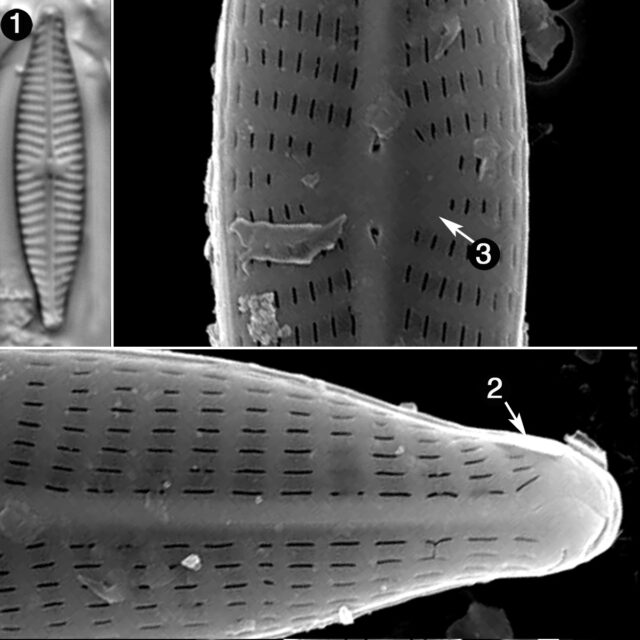Navicula trilatera
-
Category
-
Length Range17.6-26.3 µm
-
Width Range4.5-5.5 µm
-
Striae in 10 µm15-17
-
ContributorLoren Bahls - Oct 2012
-
ReviewerSarah Spaulding - Aug 2013
Identification
Description
Valves are linear-lanceolate with subrostrate apices. The axial area is very narrow and widens into a moderately large, irregular, rhombic to transversely rectangular central area. The raphe is filiform with weakly expanded and widely spaced proximal pores. Distal raphe ends are shaped like question marks and hooked in the same direction. Striae are radiate near the valve center and become convergent towards the apices. Striae in the central area are irregularly shortened or may be missing. Areolae are difficult to resolve in LM and number about 40 in 10 µm.
Autecology
In addition to the type locality, Navicula trilatera has been confirmed from another wetland in Waterton Lakes National Park, from Camas Creek on the west side of Glacier National Park, and from Horseman Flat Lake in the Beartooth Mountains of southern Montana. These waters drain three sides of the Continental Divide: north to the Saskatchewan River, west to the Columbia River, and east to the Missouri River, respectively, hence the specific epithet. This species prefers cool waters with somewhat alkaline pH and low conductivity at higher elevations. At the type locality, N. trilatera is found in association with N. seibigiana.
-
Size Range, µm3
-
Motility
-
Attachment
-
Habitat
-
Colony
-
Waterbody
- Learn more about this
Original Description
Valves linear-lanceolate with subrostrate apices. Valve length 17.6–26.3 μm; valve width 4.5–5.5 μm. Axial area very narrow, widens into a moderately large but irregular central area. Raphe filiform with weakly expanded and widely spaced proximal ends. Terminal raphe fissures shaped like question marks. Striae radiate near the valve center, convergent toward the apices, 15–17 in 10 μm. Striae in the central area irregularly shortened or missing. Areolae about 40 in 10 μm.
-
AuthorBahls 2013
-
Length Range17.6-26.3 µm
-
Width4.5-5.5 µm
-
Striae in 10µm15-17
Citations & Links
Citations
Links
-
Index Nominum Algarum
Cite This Page
Bahls, L. (2012). Navicula trilatera. In Diatoms of North America. Retrieved April 25, 2024, from https://diatoms.org/species/navicula_trilatera
Responses
The 15 response plots show an environmental variable (x axis) against the relative abundance (y axis) of Navicula trilatera from all the stream reaches where it was present. Note that the relative abundance scale is the same on each plot. Explanation of each environmental variable and units are as follows:
ELEVATION = stream reach elevation (meters)
STRAHLER = distribution plot of the Strahler Stream Order
SLOPE = stream reach gradient (degrees)
W1_HALL = an index that is a measure of streamside (riparian) human activity that ranges from 0 - 10, with a value of 0 indicating of minimal disturbance to a value of 10 indicating severe disturbance.
PHSTVL = pH measured in a sealed syringe sample (pH units)
log_COND = log concentration of specific conductivity (µS/cm)
log_PTL = log concentration of total phosphorus (µg/L)
log_NO3 = log concentration of nitrate (µeq/L)
log_DOC = log concentration of dissolved organic carbon (mg/L)
log_SIO2 = log concentration of silicon (mg/L)
log_NA = log concentration of sodium (µeq/L)
log_HCO3 = log concentration of the bicarbonate ion (µeq/L)
EMBED = percent of the stream substrate that is embedded by sand and fine sediment
log_TURBIDITY = log of turbidity, a measure of cloudiness of water, in nephelometric turbidity units (NTU).
DISTOT = an index of total human disturbance in the watershed that ranges from 1 - 100, with a value of 0 indicating of minimal disturbance to a value of 100 indicating severe disturbance.

Navicula trilatera
- Valves linear-lanceolate
- Apices subrostrate
- Central area large, irregular
Navicula trilatera has linear-lanceolate valves 4.5-5.5 µm wide. Apices are subrostrate and the central area is moderately large and irregular.
 Diatoms of North America
Diatoms of North America










